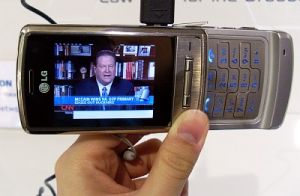Mobile TV to ride on mobile broadband popularity

update BARCELONA--The success of mobile TV over broadband will be a "natural result" of widespread mobile broadband adoption this year, say network vendors.
Ericsson CEO and president, Carl-Henric Svanberg, told journalists during a briefing at Mobile World Congress 2008 there was a strong uptake of HSPA networks last year, with this momentum expected to continue in 2008. Countries that are already operating these networks commercially are continuing to build more of them.
According to Svanberg, there are 174 HSPA networks in commercial operation in 76 countries.
 Crystal-clear live HSPA mobile TV streaming. |
With mobile TV relying on the proliferation of high-speed networks, Svanberg said: "This year is very much about mobile broadband and enabling TV over that."
HSPA is also expected to be the transmission protocol by which mobile TV will take off.
Jan Signell, Ericsson South East Asia's president, said in an interview with ZDNet Asia that HSPA is not competing with DVB-H, in spite of the latter having a headstart in the region's mobile TV market.
"Operators will know how to engage the user and know who is watching and when," said Cooney.
The challenge for operators, however, will be in wrestling users away from traditional TV.
Cooney said that the way for them to overcome that barrier will be to find differentiated offerings such as personalized content, time-shifting, HD quality and video on demand, for example.
Mobile TV is already a hit in advanced Asian countries such as Korea and Japan.
Tandberg TV was acquired last year by Ericsson.
Victoria Ho of ZDNet Asia reported from Mobile World Congress 2008 in Barcelona, Spain.